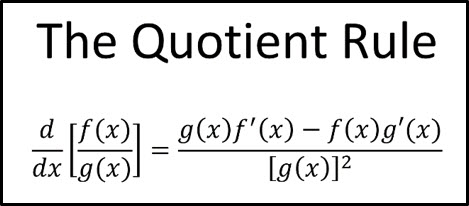Andymath.com features free videos, notes, and practice problems with answers! Printable pages make math easy. Are you ready to be a mathmagician?
Notes
Quotient Rule (Formal)
\(\displaystyle\frac{d}{dx}\left[\frac{f(x)}{g(x)}\right]=\frac{g(x)f'(x)-f(x)g'(x)}{\left[g(x)\right]^2}\)
Quotient Rule (Easy to Remember)
\(\displaystyle\frac{d}{dx}\left[\frac{hi}{lo}\right]=\frac{lo \cdot d hi\,-\,hi \cdot d lo}{lo^2}\)
Problems
Use the quotient rule to find the derivative of the following.
\(\textbf{1)}\) \(f(x)=\displaystyle\frac{x}{x^3+1}\)
\(\textbf{2)}\) \(f(x)=\displaystyle\frac{\sqrt{x}}{x^2-2}\)
\(\textbf{3)}\) \(f(x)=\displaystyle\frac{\cos x}{x^2}\) 
\(\textbf{4)}\) \(f(x)=\displaystyle\frac{x+4}{x-2}\)
\(\textbf{5)}\) \(f(x)=\displaystyle\frac{3x-4}{x^2+3}\) 
\(\textbf{6)}\) \(f(x)=\displaystyle\frac{e^x}{x}\)
\(\textbf{7)}\) \(f(x)=\displaystyle\frac{x^2}{x+1}\)
\(\textbf{8)}\) \(f(x)=\displaystyle\frac{e^x}{x+2}\)
\(\textbf{9)}\) \(f(x)=\displaystyle\frac{3x^3-2x}{1+3x}\)
\(\textbf{10)}\) Find \((f/g)'(4)\) where \(f(4)=3\), \(f'(4)=6\), \(g(4)=2\), \(g'(4)=0\)
See Related Pages\(\)
\(\bullet\text{ Calculus Homepage}\)
\(\,\,\,\,\,\,\,\,\text{All the Best Topics…}\)
\(\bullet\text{ Definition of Derivative}\)
\(\,\,\,\,\,\,\,\, \displaystyle \lim_{\Delta x\to 0} \frac{f(x+ \Delta x)-f(x)}{\Delta x} \)
\(\bullet\text{ Equation of the Tangent Line}\)
\(\,\,\,\,\,\,\,\,f(x)=x^3+3x^2−x \text{ at the point } (2,18)\)
\(\bullet\text{ Derivatives- Constant Rule}\)
\(\,\,\,\,\,\,\,\,\displaystyle\frac{d}{dx}(c)=0\)
\(\bullet\text{ Derivatives- Power Rule}\)
\(\,\,\,\,\,\,\,\,\displaystyle\frac{d}{dx}(x^n)=nx^{n-1}\)
\(\bullet\text{ Derivatives- Constant Multiple Rule}\)
\(\,\,\,\,\,\,\,\,\displaystyle\frac{d}{dx}(cf(x))=cf'(x)\)
\(\bullet\text{ Derivatives- Sum and Difference Rules}\)
\(\,\,\,\,\,\,\,\,\displaystyle\frac{d}{dx}[f(x) \pm g(x)]=f'(x) \pm g'(x)\)
\(\bullet\text{ Derivatives- Sin and Cos}\)
\(\,\,\,\,\,\,\,\,\displaystyle\frac{d}{dx}sin(x)=cos(x)\)
\(\bullet\text{ Derivatives- Product Rule}\)
\(\,\,\,\,\,\,\,\,\displaystyle\frac{d}{dx}[f(x) \cdot g(x)]=f(x) \cdot g'(x)+f'(x) \cdot g(x)\)
\(\bullet\text{ Derivatives- Quotient Rule}\)
\(\,\,\,\,\,\,\,\,\displaystyle\frac{d}{dx}\left[\displaystyle\frac{f(x)}{g(x)}\right]=\displaystyle\frac{g(x) \cdot f'(x)-f(x) \cdot g'(x)}{[g(x)]^2}\)
\(\bullet\text{ Derivatives- Chain Rule}\)
\(\,\,\,\,\,\,\,\,\displaystyle\frac{d}{dx}[f(g(x))]= f'(g(x)) \cdot g'(x)\)
\(\bullet\text{ Derivatives- ln(x)}\)
\(\,\,\,\,\,\,\,\,\displaystyle\frac{d}{dx}[ln(x)]= \displaystyle \frac{1}{x}\)
\(\bullet\text{ Implicit Differentiation}\)
\(\,\,\,\,\,\,\,\,\)
\(\bullet\text{ Horizontal Tangent Line}\)
\(\,\,\,\,\,\,\,\,\)
\(\bullet\text{ Mean Value Theorem}\)
\(\,\,\,\,\,\,\,\,\)
\(\bullet\text{ Related Rates}\)
\(\,\,\,\,\,\,\,\,\)
\(\bullet\text{ Increasing and Decreasing Intervals}\)
\(\,\,\,\,\,\,\,\,\)
\(\bullet\text{ Intervals of concave up and down}\)
\(\,\,\,\,\,\,\,\,\)
\(\bullet\text{ Inflection Points}\)
\(\,\,\,\,\,\,\,\,\)
\(\bullet\text{ Graph of f(x), f'(x) and f”(x)}\)
\(\,\,\,\,\,\,\,\,\)
\(\bullet\text{ Newton’s Method}\)
\(\,\,\,\,\,\,\,\,x_{n+1}=x_n – \displaystyle \frac{f(x_n)}{f'(x_n)}\)

In Summary
The Quotient Rule is a mathematical formula that allows us to differentiate a function that is the quotient of two other functions. In other words, it allows us to find the derivative of a function that is expressed as the division of one function by another.
The formal definition of the Quotient Rule states that if we have two functions, \(f(x)\) and \(g(x)\), the derivative of their quotient, \(h(x) = f(x)/g(x)\), is given by the formula: \(h'(x) = \displaystyle\frac{g(x) \cdot f'(x) – f(x) \cdot g'(x)}{g(x)^2}\).
The Quotient Rule is typically taught early on in a Calculus class. It is one of the most popular rules related to taking derivatives.
One common mistake when using the Quotient Rule is to use it for something like \(f(x)=\frac{3}{(x+5)^2}\). Since the 3 in the denominator is a constant, the quotient rule is not the easiest way to find the derivative. You can rewrite the function as \(f(x)=3(x+5)^{-2}\) and use the power rule for derivatives. While both methods will work, this second method should be much quicker.
A fun fact about the Quotient Rule is that it was developed by mathematician and philosopher Gottfried Wilhelm Leibniz, who is known for his contributions to calculus and the development of the notation we use today. Leibniz is often credited as the co-inventor of calculus, along with Sir Isaac Newton.
The Quotient Rule, the Power Rule, the Chain Rule, and the Product Rule are the first methods you learn to find the derivatives of functions.
About Andymath.com
Andymath.com is a free math website with the mission of helping students, teachers and tutors find helpful notes, useful sample problems with answers including step by step solutions, and other related materials to supplement classroom learning. If you have any requests for additional content, please contact Andy at tutoring@andymath.com. He will promptly add the content.
Topics cover Elementary Math, Middle School, Algebra, Geometry, Algebra 2/Pre-calculus/Trig, Calculus and Probability/Statistics. In the future, I hope to add Physics and Linear Algebra content.
Visit me on Youtube, Tiktok, Instagram and Facebook. Andymath content has a unique approach to presenting mathematics. The clear explanations, strong visuals mixed with dry humor regularly get millions of views. We are open to collaborations of all types, please contact Andy at tutoring@andymath.com for all enquiries. To offer financial support, visit my Patreon page. Let’s help students understand the math way of thinking!
Thank you for visiting. How exciting!